
A Response to the ONC's RFI on EHR Reporting: Part 1
This is KLAS Research's response to the ONC's request for information regarding the 21st Century Cures Act EHR Reporting Program.
Dear Dr. Rucker:
On behalf of KLAS Research and the Arch Collaborative, I am writing to provide comments in response to the Request for Information – 21st Century Cures Act EHR Reporting Program. KLAS Research is a research and insights firm on a global mission to improve healthcare delivery by amplifying the provider's voice.
The Arch Collaborative, which is affiliated with KLAS, is a global, provider-led effort to improve EHR usability and satisfaction through consistent measurement with the Net EHR Experience Score,[1] benchmarking, and collaboration around best practices.
We support your efforts to improve EHR usability and encourage providers to seek reliable, independent, and user-derived data regarding the capacity of EHR vendors to meet providers’ needs. We also seek to bring your attention to research by KLAS and the Arch Collaborative suggesting that EHR satisfaction and usability are directly related to the extent and quality of training users have received. This research has involved 133 organizations in the US, Europe, Singapore, Australia, and the Netherlands, including direct responses from more than 50,000 clinicians. The main findings of this research are:
- EHR satisfaction is directly related to the impact of the EHR training a clinician receives upon initial use of the EHR.
- Organizations that focus training on supporting clinician workflows have higher EHR satisfaction than those that don’t.
- Ongoing EHR education is also important to help clinicians achieve and retain their mastery of the EHR environment.
- The higher the levels of personalization-tool use by the clinicians, the higher the EHR satisfaction score.
1. EHR satisfaction is directly related to the impact of the EHR training a clinician receives upon initial use of the EHR.
As shown in Figure 1, the EHR satisfaction score is directly related to the impact of EHR training a clinician receives upon beginning to use the EHR. EHR satisfaction is directly associated with usability. 83% of clinicians are happy with their EHRs if they start out with good training, while only 36% are happy if they consider their training to be bad.[2] Good initial EHR training drives higher levels of EHR satisfaction (see Figure 1).
Figure 1
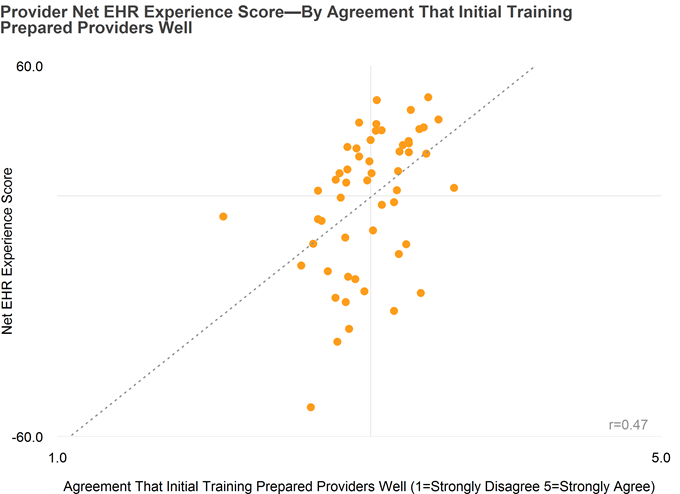
2. Organizations that focus training on supporting clinician workflows have higher EHR satisfaction than those that don’t.
Another factor influencing EHR usability is training that supports the care-delivery workflows of the clinicians. Organizations that focus training on supporting clinician workflows have higher EHR satisfaction than those that don’t (see Figure 2). One way to measure a vendor’s support for workflow training is to assess how many workflow training templates are provided specific to types of clinicians and specialists.
Figure 2
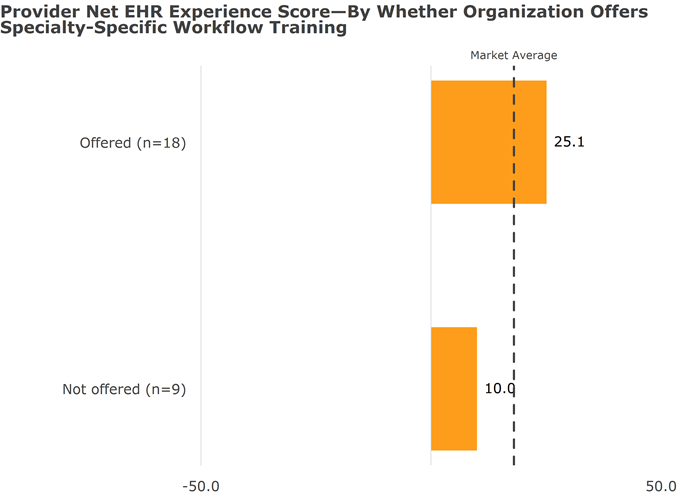
3. Ongoing EHR education is important to helping clinicians achieve and retain their mastery of the EHR environment.
Ongoing EHR education is important to helping clinicians achieve and retain their mastery of the EHR environment. EHRs are not static environments. Most healthcare organizations update their EHRs to more current versions on an annual basis. EHR upgrades add features, functions, and personalization tools that may impact how the EHR can support clinician workflows. It is imperative that organizations create ongoing education programs that keep their clinicians up to date on EHR capabilities, including new functions that may improve clinician efficiency with the EHR. Arch Collaborative findings suggest that three to five hours of annual ongoing EHR education will support higher levels of clinician satisfaction with the EHR (see Figure 3).
Figure 3
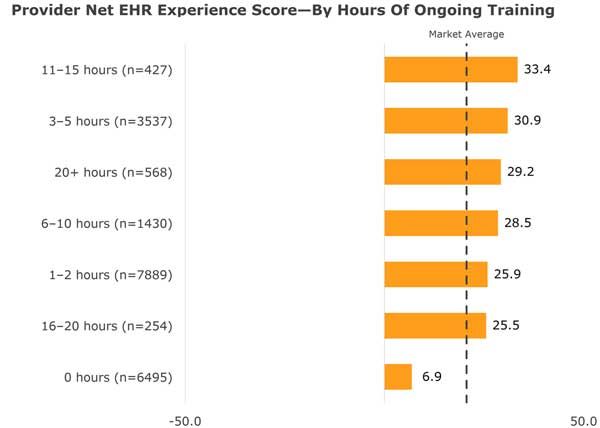
In cases where online training content is available, provider EHR satisfaction is positively correlated to the amount of training content. Organizations whose providers have access to 10 or more hours of online training content have almost twice the EHR satisfaction scores (see Figure 4) of organizations that provide less than 10 hours of content. Some online training content can be populated by the EHR vendor, while some provider organizations create their own training content.
Figure 4
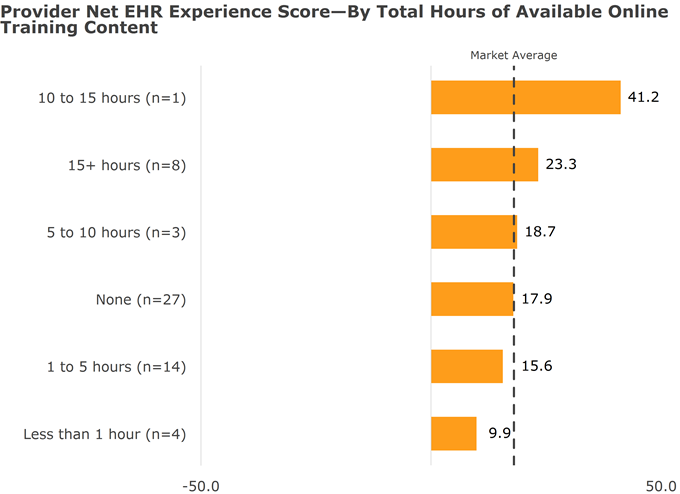
4. The higher the levels of personalization-tool use by the clinicians, the higher the EHR satisfaction score.
Another Arch Collaborative finding is that the higher the levels of personalization-tool use by the clinicians, the higher the EHR satisfaction score (see Figure 5). This is especially true for organizations that train clinicians to use personalization tools for more easily navigating and retrieving patient data from the EHR. Clinicians have learned how to enter data into the EHR to report required quality metrics.
To improve EHR usability and clinician satisfaction with the EHR, clinicians need to be able to more easily navigate and get data out of the EHR with tools such as shortcuts, sort orders, layouts, and report views. Clinicians who adopt these personalization tools are more satisfied than clinicians who do not.
Therefore, another measurement of EHR usability should be the number of personalization tools available within the EHR that improve clinician workflow efficiency for data input, EHR navigation, and data retrieval.
Figure 5
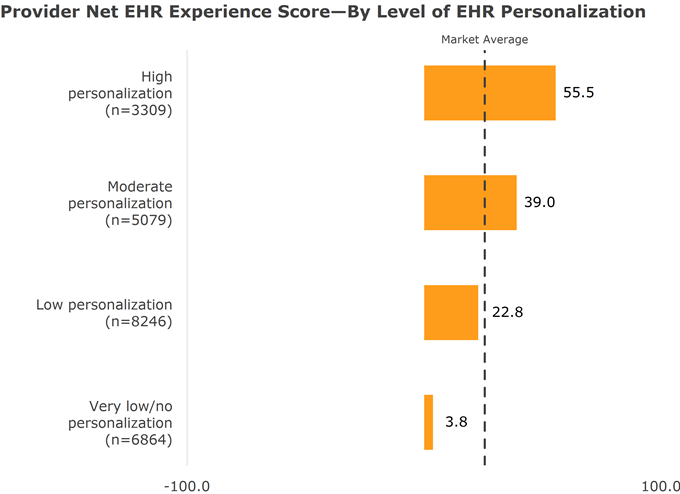
Conclusion
EHRs are not simple enough to be operated efficiently without ample instruction. It is essential that new providers spend enough time learning how to use the EHR, and it is requisite that providers have the option to participate in ongoing training each year.
The structure of training matters less than the availability and quality of the education. It is also quite helpful to teach providers how the EHR should be used in their specialty.
Providers should feel encouraged to participate in the ongoing training that best meets their needs. This could be done through online content, classes offering CME credit, distraction-free off-site classes, or at-the-elbow support throughout the year. When an EHR training program is well designed, there will be a demand to attend.
A trend that has been noted is that success begets success; when providers share how EHR training has improved their efficiency, their peers become more likely to participate. The key is that the providers must have the option to choose what works for them.
Thank you for this opportunity to comment. We are available to discuss these issues at your convenience.
Sincerely,
Taylor Davis
Vice President of Innovation
KLAS Research
Arch Collaborative
[1] The KLAS Net EHR Experience Score is created by measuring clinician agreement or disagreement that EHR capabilities are meeting their needs, using a model similar to a net promoter score.
[2] EHR Mastery: The Impact of Training, Arch Collaborative Impact Report 2018.